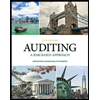
a.
Identify the transaction cycle that is audited for each
a.
Explanation of Solution
| Audit procedure | Transaction cycle |
| Collection of evidence related to internal verification of price, extensions and quantities by examining sales invoice | Revenue |
| Examine the items in company’s warehouse by selecting items from client’s perpetual inventory records | Inventory and warehousing |
| Using audit software to foot and cross foot the cash disbursements journal and trace the balance to the general ledger | Acquisition and payment |
| Determine whether the management has included key disclosures in the footnotes to the financial statements by examining loan agreement for important information | Capital acquisition and repayment |
| Determine the existence of entries by tracing sample entries in the acquisition journal to the related vendor’s invoice | Acquisition and payment |
| Determine whether the acquisition transactions are recorded in proper period by examining documentation before and after the | Acquisition and payment |
| Compute inventory turnover for major products and compare with previous years | Inventory and warehousing |
| Confirm sample of note payable balances, collateral and interest rates with lenders | Capital acquisition and repayment |
| Use audit software to foot the | Revenue |
Table (1)
b.
Identify the type of evidence for each audit procedure enlisted
b.
Explanation of Solution
| Audit procedure | Evidence type |
| Collection of evidence related to internal verification of price, extensions and quantities by examining sales invoice | Inspection |
| Examine the items in company’s warehouse by selecting items from client’s perpetual inventory records | Physical Examination |
| Using audit software to foot and cross foot the cash disbursements journal and trace the balance to the general ledger | Recalculation |
| Determine whether the management has included key disclosures in the footnotes to the financial statements by examining loan agreement for important information | Confirmation |
| Determine the existence of entries by tracing sample entries in the acquisition journal to the related vendor’s invoice | Inspection |
| Determine whether the acquisition transactions are recorded in proper period by examining documentation before and after the balance sheet date | Inspection |
| Compute inventory turnover for major products and compare with previous years | Analytical Procedure |
| Confirm sample of note payable balances, collateral and interest rates with lenders | Confirmation |
| Use audit software to foot the accounts receivable trial balance and compare the balance with the general ledger | Recalculation |
Table (2)
c.
Identify whether the audit procedures are test of control or substantive test
c.
Explanation of Solution
| Audit procedure | Type of procedure |
| Collection of evidence related to internal verification of price, extensions and quantities by examining sales invoice | Test of control |
| Examine the items in company’s warehouse by selecting items from client’s perpetual inventory records | Substantive |
| Using audit software to foot and cross foot the cash disbursements journal and trace the balance to the general ledger | Substantive |
| Determine whether the management has included key disclosures in the footnotes to the financial statements by examining loan agreement for important information | Substantive |
| Determine the existence of entries by tracing sample entries in the acquisition journal to the related vendor’s invoice | Test of control or substantive |
| Determine whether the acquisition transactions are recorded in proper period by examining documentation before and after the balance sheet date | Substantive |
| Compute inventory turnover for major products and compare with previous years | Substantive |
| Confirm sample of note payable balances, collateral and interest rates with lenders | Substantive |
| Use audit software to foot the accounts receivable trial balance and compare the balance with the general ledger | Substantive |
Table (3)
d.
Identify whether the audit procedures enlisted are substantive test of transactions, test of details of balances or a substantive analytical procedure.
d.
Explanation of Solution
| Audit procedure | Evidence type |
| Collection of evidence related to internal verification of price, extensions and quantities by examining sales invoice | Not applicable |
| Examine the items in company’s warehouse by selecting items from client’s perpetual inventory records | Test of details of balances |
| Using audit software to foot and cross foot the cash disbursements journal and trace the balance to the general ledger | Substantive test of transactions |
| Determine whether the management has included key disclosures in the footnotes to the financial statements by examining loan agreement for important information | Test of details of balances |
| Determine the existence of entries by tracing sample entries in the acquisition journal to the related vendor’s invoice | Substantive test of transactions |
| Determine whether the acquisition transactions are recorded in proper period by examining documentation before and after the balance sheet date | Substantive test of transaction |
| Compute inventory turnover for major products and compare with previous years | Analytical Procedure |
| Confirm sample of note payable balances, collateral and interest rates with lenders | Test of details of balances |
| Use audit software to foot the accounts receivable trial balance and compare the balance with the general ledger | Test of details of balances |
Table (4)
e.
Identify transaction related audit objectives being satisfied for each substantive test or test of control of transaction procedure
e.
Explanation of Solution
| Audit procedure | Objectives satisfied |
| Collection of evidence related to internal verification of price, extensions and quantities by examining sales invoice | Accuracy |
| Examine the items in company’s warehouse by selecting items from client’s perpetual inventory records | Not applicable |
| Using audit software to foot and cross foot the cash disbursements journal and trace the balance to the general ledger | Not applicable |
| Determine whether the management has included key disclosures in the footnotes to the financial statements by examining loan agreement for important information | Accuracy |
| Determine the existence of entries by tracing sample entries in the acquisition journal to the related vendor’s invoice | Occurrence |
| Determine whether the acquisition transactions are recorded in proper period by examining documentation before and after the balance sheet date | Not applicable |
| Compute inventory turnover for major products and compare with previous years | Not applicable |
| Confirm sample of note payable balances, collateral and interest rates with lenders | Not applicable |
| Use audit software to foot the accounts receivable trial balance and compare the balance with the general ledger | Not applicable |
Table (5)
f.
Identify the balance related audit objectives being satisfied for each test of details of balance procedure or substantive analytical procedure.
f.
Explanation of Solution
| Audit procedure | Objectives satisfied |
| Collection of evidence related to internal verification of price, extensions and quantities by examining sales invoice | Not applicable |
| Examine the items in company’s warehouse by selecting items from client’s perpetual inventory records |
Existence |
| Using audit software to foot and cross foot the cash disbursements journal and trace the balance to the general ledger | Detail tie in |
| Determine whether the management has included key disclosures in the footnotes to the financial statements by examining loan agreement for important information | Accuracy |
| Determine the existence of entries by tracing sample entries in the acquisition journal to the related vendor’s invoice | Existence |
| Determine whether the acquisition transactions are recorded in proper period by examining documentation before and after the balance sheet date | Not applicable |
| Compute inventory turnover for major products and compare with previous years | Realizable value |
| Confirm sample of note payable balances, collateral and interest rates with lenders | Existence and accuracy |
| Use audit software to foot the accounts receivable trial balance and compare the balance with the general ledger | Detail tie in |
Table (6)
Want to see more full solutions like this?
Chapter 13 Solutions
Mylab Accounting With Pearson Etext -- Access Card -- For Auditing And Assurance Services (17th Edition)
- I am looking for the correct answer to this general accounting question with appropriate explanations.arrow_forwardI am looking for the correct answer to this general accounting question with appropriate explanations.arrow_forwardPlease provide the answer to this general accounting question with proper steps.arrow_forward
 Auditing: A Risk Based-Approach (MindTap Course L...AccountingISBN:9781337619455Author:Karla M Johnstone, Audrey A. Gramling, Larry E. RittenbergPublisher:Cengage LearningCentury 21 Accounting Multicolumn JournalAccountingISBN:9781337679503Author:GilbertsonPublisher:Cengage
Auditing: A Risk Based-Approach (MindTap Course L...AccountingISBN:9781337619455Author:Karla M Johnstone, Audrey A. Gramling, Larry E. RittenbergPublisher:Cengage LearningCentury 21 Accounting Multicolumn JournalAccountingISBN:9781337679503Author:GilbertsonPublisher:Cengage Accounting Information SystemsAccountingISBN:9781337619202Author:Hall, James A.Publisher:Cengage Learning,
Accounting Information SystemsAccountingISBN:9781337619202Author:Hall, James A.Publisher:Cengage Learning,



